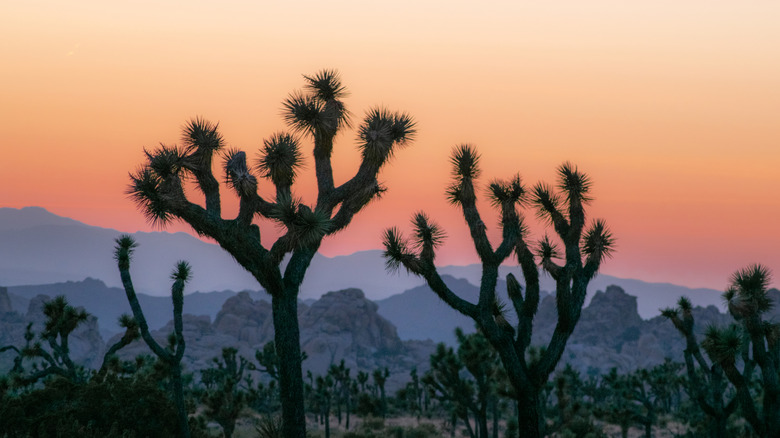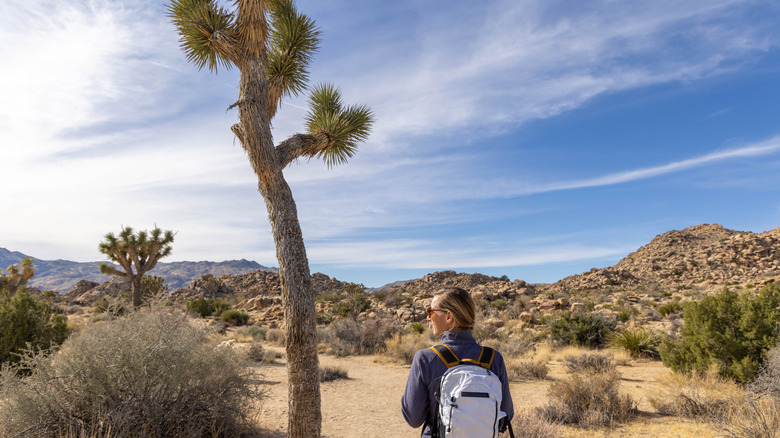The World's Largest Joshua Tree Forest Is A Spiritual Nevada Park With Stunning Trails And Grand Vistas
In the Mojave Desert, where Nevada meets Southern California, a new national monument now protects over 500,000 acres of land. The park is home to the world's largest concentration of Joshua trees, the oldest of which have been there for over 900 years. Avi Kwa Ame was designated a national monument in 2023 by former President Joe Biden. Avi Kwa Ame translates from the Mojave language to "Spirit Mountain" in English, which is also the name of a mountain that sits on the protected land. The park is visually stunning and is considered a sacred site among Indigenous tribes, such as the Hopi and Southern Paiute people.
Located 80 miles south of Las Vegas, Nevada, the "most fun city in America," this park serves as a perfect day trip from Sin City or as a destination that stands on its own. Las Vegas' Harry Reid International Airport (LAS) is the nearest travel hub. Once you're out in the desert, the location is fairly remote. There are no designated campsites in Avi Kwa Ame. However, primitive camping is legal and allowed in most of the park, so long as you leave no trace behind and camp at least 200 yards from a water source. Just outside of the park, you'll find campgrounds, glamping sites, motels, and resorts to fit every budget. Plus, its proximity to Vegas means plenty of desert casinos — and where there's a casino, there's almost always a buffet.
Hike through some of the largest and oldest Joshua trees on Earth
Even more spectacular than the famed Joshua Tree National Park, home to one of the world's best sunset-viewing spots, Avi Kwa Ame holds the title for the world's largest Joshua tree forest. The park is even home to the largest Joshua tree in Nevada, also among the largest in the world. One of the easiest trails to hike in the park is the Joshua Tree Trail, which is a 3-mile stretch of flat terrain that winds through the unique trees. There are all kinds of hikes to choose from, including the 3.9-mile trek through the Wee Thump Joshua Tree Wilderness Area, and the breathtaking Castle Mountains Grasslands Trail. As you wander, you may spot some of the area's local wildlife like the desert tortoise and bighorn sheep. The Hiko Springs Canyon trail is incredibly scenic and features several ancient petroglyphs.
If you'd prefer to enjoy the grand vistas from the comfort of your car, there are several drivable sections. The Christmas Tree Pass Scenic Loop, for instance, is a 12-mile scenic drive and one of the most geologically interesting sections of the park, with a mix of unique mountain rocks and juniper trees. The Castle Peaks Trail is also a drivable route with historic sights.
The spiritual significance of Avi Kwa Ame
The designation of Avi Kwa Ame as a national monument holds important meaning as a spiritual site, particularly for the 10 Yuman-speaking Tribal nations of the Mojave. Spirit Mountain is a key part of creation stories, which describe their ancestors emerging from the mountain's rocks. But the entire region around the mountain is sacred and home to stories, ceremonies, and practices. "Of all the spiritual lands and sacred places in the area, Avi Kwa Ame is the most sacred and important to us," said Bianca Otero of the Fort Mojave Indian Tribe in a video from Conservation Lands Foundation. Today, it remains a cultural epicenter and a beloved destination among tribal groups and visitors alike.
Aside from the site's spiritual importance, it is immensely significant to the tribes of the region for its cultural, ecological, and medicinal resources. "To communicate with all living creatures, and protect and respect the earth, was and still is our tradition," Paul Jackson of the Aha Macav people wrote for the Conservation Lands Foundation. " ... All we ask is to love this land as we have, care for it as we have, protect it and respect it as we have. For the whole world is precious." The designation of the national monument has protected the land and ensured its ecological and recreational use as well as its cultural protection. But perhaps most importantly, it will remain a site for future generations to grow up in, pass down stories and traditions, and enjoy the land as it has been for thousands of years.


